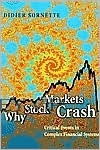
CHAPTER 1
FINANCIAL CRASHES: WHAT, HOW, WHY, AND WHEN?
WHAT ARE CRASHES, AND WHY DO WE CARE?
Stock market crashes are momentous financial events that are
fascinating to academics and practitioners alike. According to the
academic world view that markets are efficient, only the revelation
of a dramatic piece of information can cause a crash, yet in reality
even the most thorough post-mortem analyses are typically
inconclusive as to what this piece of information might have been.
For traders and investors, the fear of a crash is a perpetual source of
stress, and the onset of the event itself always ruins the lives of
some of them.
Most approaches to explaining crashes search for possible
mechanisms or effects that operate at very short time scales (hours,
days, or weeks at most). This book proposes a radically different
view: the underlying cause of the crash will be found in the
preceding months and years, in the progressively increasing build-
up of market cooperativity, or effective interactions between
investors, often translated into accelerating ascent of the market
price (the bubble). According to this “critical” point of view, the
specific manner by which prices collapsed is not the most important
problem: a crash occurs because the market has entered an unstable
phase and any small disturbance or process may have triggered the
instability. Think of a ruler held up vertically on your finger: this
very unstable position will lead eventually to its collapse, as a result
of a small (or an absence of adequate) motion of your hand or due
to any tiny whiff of air. The collapse is fundamentally due to the
unstable position; the instantaneous cause of the collapse is
secondary. In the same vein, the growth of the sensitivity and the
growing instability of the market close to such a critical point might
explain why attempts to unravel the local origin of the crash have
been so diverse. Essentially, anything would work once the system is
ripe. This book explores the concept that a crash has fundamentally
an endogenous, or internal, origin and that exogenous, or external,
shocks only serve as triggering factors. As a consequence, the origin
of crashes is much more subtle than often thought, as it is
constructed progressively by the market as a whole, as a self-
organizing process. In this sense, the true cause of a crash could be
termed a systemic instability.
Systemic instabilities are of great concern to governments,
central banks, and regulatory agencies. The question that
often arose in the 1990s was whether the new, globalized,
information technology–driven economy had advanced to the point
of outgrowing the set of rules dating from the 1950s, in effect
creating the need for a new rule set for the “New Economy.” Those
who make this call basically point to the systemic instabilities since
1997 (or even back to Mexico’s peso crisis of 1994) as evidence that
the old post–World War II rule set is now antiquated, thus
condemning this second great period of globalization to the same
fate as the first. With the global economy appearing so fragile
sometimes, how big a disruption would be needed to throw a
wrench into the world’s financial machinery? One of the leading
moral authorities, the Basle Committee on Banking Supervision,
advised that, “in handling systemic issues, it will be necessary
Why Stock Markets Crash: Critical Events in Complex Financial Systems by Didier Sornette




